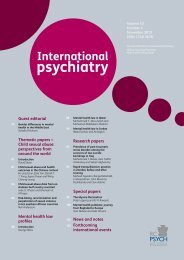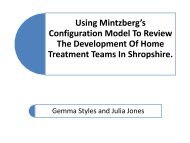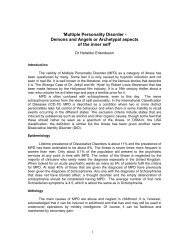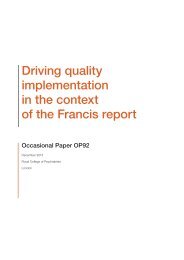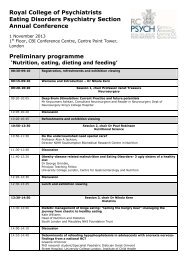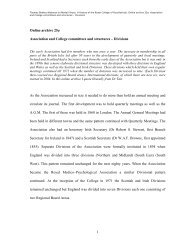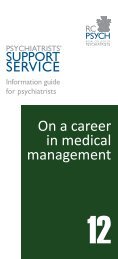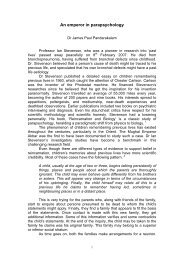Ensuring Continuity of Care in the Community
Ensuring Continuity of Care in the Community
Ensuring Continuity of Care in the Community
You also want an ePaper? Increase the reach of your titles
YUMPU automatically turns print PDFs into web optimized ePapers that Google loves.
The rationale for <strong>in</strong>terven<strong>in</strong>g with <strong>of</strong>fenders<br />
with common mental health problems near<br />
to release<br />
richard.byng@pms.ac.uk<br />
Pen<strong>in</strong>sula Medical School, NHS Plymouth<br />
Funded by <strong>the</strong> NIHR <strong>in</strong>clud<strong>in</strong>g a contribution<br />
from <strong>the</strong> Pen<strong>in</strong>sula NIHR CLAHRC<br />
The views expressed <strong>in</strong> this presentation are those <strong>of</strong> <strong>the</strong> author and not necessarily those <strong>of</strong> <strong>the</strong><br />
<strong>the</strong> NIHR or <strong>the</strong> Department <strong>of</strong> Health<br />
Forensic Conference 1-3 February 2012
Overview<br />
• Discont<strong>in</strong>uity: a collusion <strong>of</strong> distrust and<br />
disorganisation<br />
• What is <strong>the</strong> need?<br />
• What k<strong>in</strong>d <strong>of</strong> service?<br />
Forensic Conference 1-3 February 2012
Distrust<br />
“I don’t trust <strong>the</strong> system one bit, I hate <strong>the</strong><br />
system. All <strong>the</strong>y’ve ever done is shit on my life.<br />
Why should I trust <strong>the</strong>m? Probation, <strong>the</strong>y’ve<br />
shit on me, DTTO, <strong>the</strong>y shit on me, CORUS<br />
<strong>the</strong>y shit on you, everybody shits on you. So I<br />
don’t trust noth<strong>in</strong>g or no-one. I don’t trust my<br />
missus, I don’t trust my own mum and if I don’t<br />
trust my own mum I a<strong>in</strong>’t go<strong>in</strong>g to trust no-<br />
one(R4).”<br />
Howerton, Byng, et al BMJ, 2007<br />
Understand<strong>in</strong>g help seek<strong>in</strong>g behaviour among male <strong>of</strong>fenders<br />
Forensic Conference 1-3 February 2012
NIHR SDO funded Study (2008-2011)<br />
200 <strong>of</strong>fenders – 53% identified mental health<br />
issues<br />
Low access to mental health care<br />
High access to substance misuse care<br />
Forensic Conference 1-3 February 2012
• Prison and community<br />
Discont<strong>in</strong>uities<br />
• Physical and mental health, and substance misuse<br />
• Health and social <strong>in</strong>clusion<br />
Opportunities:<br />
• Probation and Prison<br />
Forensic Conference 1-3 February 2012
General Practice Outreach:<br />
Gateway to Health - Plymouth<br />
• Shared care with forensic team<br />
• Pre-booked by GPs, forensic team and Probation.<br />
• Rudimentary data shar<strong>in</strong>g and jo<strong>in</strong>t care plans<br />
• Regular corridor discussions with probation<br />
• Electronic records at multiple locations<br />
Forensic Conference 1-3 February 2012
Engager 1<br />
NIHR funded feasibility study 2010-11<br />
Pen<strong>in</strong>sula and Manchester<br />
Aims:<br />
• Develop a model for engag<strong>in</strong>g and reta<strong>in</strong><strong>in</strong>g <strong>of</strong>fenders<br />
• Feasibility for recruit<strong>in</strong>g and follow<strong>in</strong>g up after release<br />
to a trial <strong>of</strong> a ‘bridg<strong>in</strong>g’ <strong>in</strong>tervention<br />
• Fur<strong>the</strong>r def<strong>in</strong>e need<br />
Forensic Conference 1-3 February 2012
Engager 1 - method<br />
An ‘ engag<strong>in</strong>g’ <strong>in</strong>terview schedule, and follow up process<br />
was designed us<strong>in</strong>g literature, focus groups and case<br />
studies<br />
Schedule assessed:<br />
• PHQ-9, GAD-7, PTSD screen,<br />
• ‘past bad stress’<br />
• SAPAS<br />
• Drug and alcohol measures, Social <strong>in</strong>clusion measure<br />
• Will<strong>in</strong>gness to receive help<br />
SMI excluded<br />
Follow up <strong>of</strong> current, past CMHPs and<br />
SAPAS positive cases<br />
Forensic Conference 1-3 February 2012
Engager 1 - feasibility<br />
Cohort <strong>of</strong> prison leavers dest<strong>in</strong>ed for nearby localities<br />
169 (84%) <strong>of</strong> 201 approached 2-8 week prior to<br />
release participated<br />
114 (67%) met criteria for present or past CMHP or<br />
likely PD, would accept help and be followed up<br />
53 to date (54%, estimated f<strong>in</strong>al) have been followed<br />
up 2-8 weeks follow<strong>in</strong>g release<br />
Forensic Conference 1-3 February 2012
Engager 1- need<br />
From cohort <strong>of</strong> 169 <strong>in</strong>terviewed:<br />
11 – Severe mental illness (Current psychosis, bipolar)<br />
58 – Current common mental health problem +/- SAPAS<br />
19 - Past common mental health problem +/- SAPAS<br />
51 - SAPAS only<br />
30 – None <strong>of</strong> above<br />
Of 58 with CCMHPs:<br />
55 for PHQ-9, 40 for GAD-7 and 37 for PTSD screen<br />
19% were at case for all three<br />
Of 128 eligible by diagnosis114 said <strong>the</strong>y<br />
would accept help and were followed up<br />
Forensic Conference 1-3 February 2012
Engager 1 – need at f/u<br />
Of 53 followed up so far:<br />
29 cases(19 - PHQ-9, 12 - GAD-7, 9 for PTSD)<br />
9 past case only<br />
15 SAPAS only<br />
Of orig<strong>in</strong>al CCMHPs 36% rema<strong>in</strong>ed cases<br />
Of orig<strong>in</strong>al PCMHP 33% met caseness for common<br />
mental health problems at follow up.<br />
If SAPAS only orig<strong>in</strong>ally 7% met caseness for common<br />
mental health problems at follow up.<br />
50% significant need for accommodation<br />
81% were unemployed<br />
75% had problems with alcohol<br />
40% had substance Forensic misuse Conference problems.<br />
1-3 February 2012
Engager 1 – summary <strong>of</strong> need<br />
Confirms high level <strong>of</strong> CMHPs, Substance<br />
misuse, PD <strong>in</strong> prisoners near to release<br />
• Not receiv<strong>in</strong>g help<br />
• 36% stay CMHP cases after release<br />
• 33% <strong>of</strong> past cases return to caseness after<br />
release<br />
• SAPAS only - tend not to become cases<br />
• High levels <strong>of</strong> substance and alcohol misuse <strong>in</strong><br />
all groups<br />
• Unemployment and homelessness<br />
Will<strong>in</strong>g to accept help and participate<br />
Forensic Conference 1-3 February 2012
What k<strong>in</strong>d <strong>of</strong> service?<br />
Barriers to overcome:<br />
• Distrust and unwill<strong>in</strong>gness to admit ‘mental’<br />
• Discont<strong>in</strong>uities created by CJS<br />
• Silo based health services<br />
Opportunities to exploit:<br />
• Will<strong>in</strong>gness to talk<br />
• Motivators – family, home, work<br />
• ? Strengths<br />
• IAPT<br />
Forensic Conference 1-3 February 2012
Identify<br />
Engage<br />
assess<br />
Proposed model<br />
Prison<br />
services<br />
Engage,<br />
liaise,<br />
set up transfer<br />
Enhanced GP care,<br />
substance misuse<br />
services<br />
IAPT or 2 o mental health<br />
• Initial prison contact<br />
• Through <strong>the</strong> gate<br />
• Case manager<br />
• Therapy<br />
• Liaise<br />
Forensic Conference 1-3 February 2012<br />
Social <strong>in</strong>clusion<br />
services
ichard.byng@pms.ac.uk<br />
Forensic Conference 1-3 February 2012




